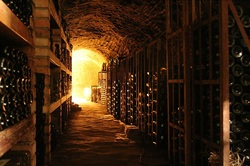
One or two fermentations happen in wine, alcoholic and malolactic. Alcoholic fermentation turns sugar into alcohol. Malolactic fermentation turns malic acid (sharp apple flavours) into malic acid (creamy or milky).
No further fermentation takes place in the bottle, or at least it shouldn't on most wines. It would develop unwanted flavours (faults) or fizziness. The exception being sparkling wine production, where some sugar is left to achieve a second fermentation in the bottle which gives carbon dioxide (bubbles).
Having said that, David is correct in that a few processes take place inside the bottle. Bottles are not air tight, miniscule parts of oxigen leave the wine through the cork during aging, almost negligable evaporation. This evaporation diminishes the risk of negative changes in the wine.
Without oxygen, complex flavours and odours are formed by the interaction between acids and alcohols within the bottle. This process is called esterification. Through esterification sharp acids in young wines are mellowed out while more complex fruit aromas develop. These complex aromas or esters and are naturally present in the essential oils of plants.
We therefore associate wine flavours and scents with fruit and flower aromas. This is how primary aromas naturally present in wines develop to more complex aromas called bouquet. The term bouquet itself is an analogy to flowers: our senses associate the roundness and complexity (bouquet) of a wine to be more than just the sum of individual (aromas) elements.

 RSS Feed
RSS Feed
